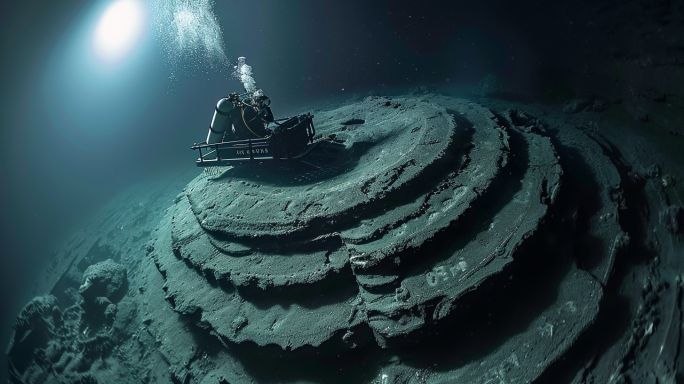Introduction
The Baltic Sea Anomaly has captivated the imaginations of both scientists and the general public since its discovery in 2011. This enigmatic, circular formation lying at the bottom of the Baltic Sea has sparked a plethora of theories ranging from natural geological formations to remnants of wartime technology, and even the possibility of an extraterrestrial craft. Despite numerous attempts to uncover the truth, the anomaly remains one of the most intriguing underwater mysteries of our time.
Discovery of the Anomaly
In June 2011, a team of Swedish treasure hunters known as the Ocean X team, led by Peter Lindberg and Dennis Åsberg, stumbled upon a bizarre object while searching for a sunken ship in the Baltic Sea. The team was using sonar to explore the seabed when they encountered a large, disc-shaped structure approximately 60 meters in diameter, sitting 90 meters below the surface.
Description of the Anomaly
The Baltic Sea Anomaly is described as having a distinct, circular shape, somewhat resembling a flying saucer. It is characterized by sharp edges, smooth surfaces, and a series of unusual formations that appear to be ramps or staircases leading up to a central plateau. The object also features what some describe as “drag marks,” suggesting it may have moved or been moved to its current location.
Initial Theories
Upon its discovery, the anomaly quickly drew attention and speculation. Initial theories ranged from it being a natural rock formation shaped by glacial activity, to a man-made structure, possibly a remnant of a World War II anti-submarine device. The most sensational theory posited that it was a crashed UFO, due to its striking resemblance to depictions of extraterrestrial spacecraft.
Scientific Investigations
Numerous scientific investigations have been conducted to determine the nature of the Baltic Sea Anomaly. These studies have included sonar imaging, rock sample analysis, and underwater dives. Despite these efforts, conclusive evidence proving the anomaly’s origins remains elusive.
Natural Formation Theory
Some geologists believe that the Baltic Sea Anomaly is a natural formation, possibly created by glacial movements during the last Ice Age. This theory is supported by the presence of similar rock formations in the region. The anomaly’s structure, they argue, could be the result of natural geological processes rather than human or extraterrestrial activity.
Man-Made Object Theory
Another plausible explanation is that the anomaly is a man-made object from the World War II era. Some researchers suggest it could be an anti-submarine device or part of a sunken ship. The Baltic Sea was a significant theater of naval operations during the war, making this theory a credible possibility.
Extraterrestrial Hypothesis
The most sensational theory is that the Baltic Sea Anomaly is a crashed UFO. Proponents of this hypothesis point to its unusual shape and the perceived technological features as evidence of alien origin. This theory, while popular in certain circles, lacks substantial evidence and is often dismissed by mainstream scientists.
Sonar Imaging and Data
Sonar imaging has played a crucial role in studying the anomaly. The initial sonar scans revealed the object’s distinct shape, prompting further investigation. Subsequent dives have provided more detailed images, but the murky waters and difficult conditions have made it challenging to gather clear, comprehensive data.
Challenges in Exploration
Exploring the Baltic Sea Anomaly has proven difficult due to the depth and conditions of the site. The cold, dark waters, coupled with poor visibility and the risk of underwater currents, have hampered efforts to conduct thorough investigations. These challenges have contributed to the ongoing mystery surrounding the anomaly.
Media and Public Interest
Media coverage of the Baltic Sea Anomaly has been extensive, fueling public fascination and speculation. Documentaries, news articles, and online forums have all contributed to the intrigue, making the anomaly a popular topic among conspiracy theorists and UFO enthusiasts.
Comparative Anomalies
The Baltic Sea Anomaly is not unique; other underwater formations have sparked similar debates. Examples include the Yonaguni Monument in Japan and the Bimini Road in the Bahamas. These sites share characteristics with the Baltic Sea Anomaly and continue to be subjects of study and speculation.
Ongoing Research
Research into the Baltic Sea Anomaly is ongoing. The Ocean X team, along with other scientists and researchers, continue to explore and analyze the site. Advances in technology and underwater exploration methods may eventually provide more definitive answers.
Impact on Popular Culture
The Baltic Sea Anomaly has had a significant impact on popular culture, inspiring books, documentaries, and even video games. Its mysterious nature and the possibility of it being an alien artifact have captured the imagination of many, ensuring that the anomaly remains a topic of interest.
Conclusion
The Baltic Sea Anomaly remains one of the most compelling underwater mysteries. Whether a natural formation, a remnant of wartime activity, or something more extraordinary, its true nature continues to elude researchers. As technology advances and exploration continues, we may one day unravel the secrets of this enigmatic object.
FAQs
Q: What is the Baltic Sea Anomaly?
A: The Baltic Sea Anomaly is an unusual, circular formation discovered on the seabed of the Baltic Sea in 2011. Its origins and nature remain unexplained.
Q: Who discovered the Baltic Sea Anomaly?
A: The anomaly was discovered by the Ocean X team, a group of Swedish treasure hunters led by Peter Lindberg and Dennis Åsberg.
Q: What are the theories about the Baltic Sea Anomaly?
A: Theories include it being a natural rock formation, a World War II anti-submarine device, or an extraterrestrial spacecraft.
Q: Has the Baltic Sea Anomaly been explored?
A: Yes, it has been explored through sonar imaging and underwater dives, but conclusive evidence about its nature has not been found.
Q: Why is the Baltic Sea Anomaly important?
A: The anomaly is important due to its mysterious nature, sparking debates and research in geology, history, and ufology.

